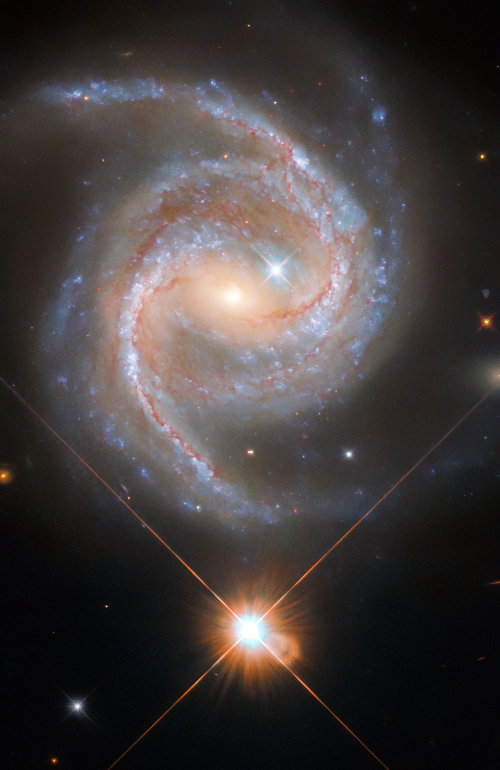A galaxy slowly being eaten by its black hole
Cool image time! The photo to the right, rotated and reduced to post here, was taken by the Hubble Space Telescope. From the caption:
NGC 5495, which lies around 300 million light-years from Earth in the constellation Hydra, is a Seyfert galaxy, a type of galaxy with a particularly bright central region. These luminous cores — known to astronomers as active galactic nuclei — are dominated by the light emitted by dust and gas falling into a supermassive black hole. This image is drawn from a series of observations captured by astronomers studying supermassive black holes lurking in the hearts of other galaxies.
Essentially Seyfert galaxies are galaxies whose central supermassive black hole has become dominant, large enough that its gravity is slowly eating up the rest of the galaxy. As it increasingly swallows stars and gas, the black hole emits more and more energy, thus becoming an active galactic nuclei.
Two stars from our own galaxy also dominate this picture, one inside and to the right of the galaxy’s center, and the other the bright star at the bottom of the picture, both identified by the diffraction spikes.
On Christmas Eve 1968 three Americans became the first humans to visit another world. What they did to celebrate was unexpected and profound, and will be remembered throughout all human history. Genesis: the Story of Apollo 8, Robert Zimmerman's classic history of humanity's first journey to another world, tells that story, and it is now available as both an ebook and an audiobook, both with a foreword by Valerie Anders and a new introduction by Robert Zimmerman.
The print edition can be purchased at Amazon or from any other book seller. If you want an autographed copy the price is $60 for the hardback and $45 for the paperback, plus $8 shipping for each. Go here for purchasing details. The ebook is available everywhere for $5.99 (before discount) at amazon, or direct from my ebook publisher, ebookit. If you buy it from ebookit you don't support the big tech companies and the author gets a bigger cut much sooner.
The audiobook is also available at all these vendors, and is also free with a 30-day trial membership to Audible.
"Not simply about one mission, [Genesis] is also the history of America's quest for the moon... Zimmerman has done a masterful job of tying disparate events together into a solid account of one of America's greatest human triumphs."--San Antonio Express-News
Cool image time! The photo to the right, rotated and reduced to post here, was taken by the Hubble Space Telescope. From the caption:
NGC 5495, which lies around 300 million light-years from Earth in the constellation Hydra, is a Seyfert galaxy, a type of galaxy with a particularly bright central region. These luminous cores — known to astronomers as active galactic nuclei — are dominated by the light emitted by dust and gas falling into a supermassive black hole. This image is drawn from a series of observations captured by astronomers studying supermassive black holes lurking in the hearts of other galaxies.
Essentially Seyfert galaxies are galaxies whose central supermassive black hole has become dominant, large enough that its gravity is slowly eating up the rest of the galaxy. As it increasingly swallows stars and gas, the black hole emits more and more energy, thus becoming an active galactic nuclei.
Two stars from our own galaxy also dominate this picture, one inside and to the right of the galaxy’s center, and the other the bright star at the bottom of the picture, both identified by the diffraction spikes.
On Christmas Eve 1968 three Americans became the first humans to visit another world. What they did to celebrate was unexpected and profound, and will be remembered throughout all human history. Genesis: the Story of Apollo 8, Robert Zimmerman's classic history of humanity's first journey to another world, tells that story, and it is now available as both an ebook and an audiobook, both with a foreword by Valerie Anders and a new introduction by Robert Zimmerman.
The print edition can be purchased at Amazon or from any other book seller. If you want an autographed copy the price is $60 for the hardback and $45 for the paperback, plus $8 shipping for each. Go here for purchasing details. The ebook is available everywhere for $5.99 (before discount) at amazon, or direct from my ebook publisher, ebookit. If you buy it from ebookit you don't support the big tech companies and the author gets a bigger cut much sooner.
The audiobook is also available at all these vendors, and is also free with a 30-day trial membership to Audible.
"Not simply about one mission, [Genesis] is also the history of America's quest for the moon... Zimmerman has done a masterful job of tying disparate events together into a solid account of one of America's greatest human triumphs."--San Antonio Express-News



This from a post I made elsewhere:
The diameter of a black hole event horizon determines the longest wave length of the radiation it can produce.
The thermal temperature of the event horizon can not yet equal the thermal temperature of the surrounding vacuum which is colder and able to radiate at longer wavelengths.
Conservation of information (things and other stuff) stored on the surface of the horizon in planck length units probably requires the condition.
Something about the vacuum/spacetime/quantum mechanics is forcing them to evaporate to lose mass, limit horizon diameter & the corresponding longest frequency radiating wavelength.
Inflation has made the vacuum colder than the black holes. Why do they resist inflation?
I was an educator, not a theorist.
I’m guessing.